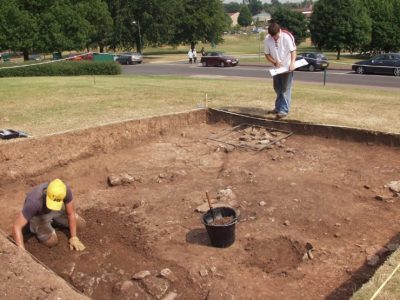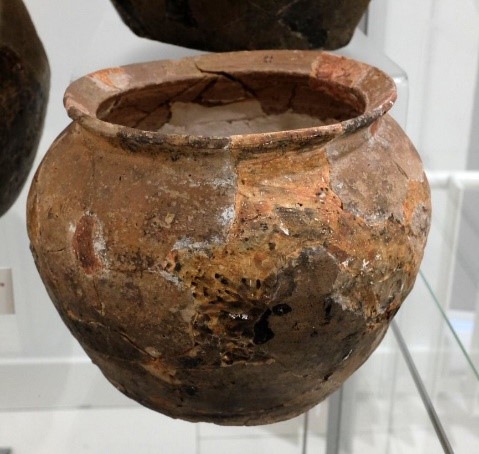May 17, 2021, by Matt Davies
Virtual Volunteering: The DTH Archaeology Museum Video Project 2020-2021 by Kavi Mistry
This year the Digital Transformations Hub has been collaborating with the University’s Museum on two student volunteer projects. One is to produce 3D digital versions of a selection of the Museum’s artefacts the other to produce information and marketing videos. You can find a report on the photogrammetry project here, this week second-year Ancient History student and DTH volunteer Kavi Mistry reports on the video project.
Work on the video project officially commenced in November. The brief, set by Museum keeper Clare Pickersgill, was for all eight volunteers to create a short film about some of the artefacts on display at the Museum. Producers were able to choose anything from the collections which took their interest. Subjects include recent excavations, Roman pottery and coins, and even a mammoth tooth. The videos will be used by the Museum for exhibitions, outreach, and marketing purposes.
The video project is run by regular DTH partner Joe Bell, a Video Production Support Officer at the University. Volunteers typically attend at least one of two hour-long virtual workshops with Joe each week in addition to conducting research, planning, recording, and editing in their own time. The team is using the video editing application DaVinci Resolve to create their videos. They have also been using GIMP, an image manipulation program, and Audacity, an audio editor and recording application.
The objective is to foster the Museum’s digital engagement by producing high-quality informative videos. These will help the Museum to continue its outreach and sustain public interest in the collections.
Keighton
My video project is about the missing medieval village of Keighton. It was once a small industrial settlement that occupied the hillside behind the bus stops on East Drive, University Park and the plot of land where the Life Sciences Building stands today. Until the 1940s, nobody knew exactly where the village had existed, though its name had been recorded in a few deeds.

Two students excavating Keighton Hill in 2006, supervised by Lloyd Laing. Credit: University of Nottingham Museum.
Keighton’s relationship with nearby Lenton Priory, a Cluniac monastic house, was typically feudal. This means that the priory provided land to Keighton’s tenants in exchange for their loyalty and services. As well as owing their labour to help with sowing and harvesting crops, the community produced roof tiles and decorative floor tiles for the priory using the site’s clay rich earth. The village prospered but was later abandoned due to flooding, widespread famine, and the bubonic plague of the 14th century.
Activity returned to the site, however, in the form of a temporary tile works. It’s likely that workers set up kilns specifically to produce tiles needed locally and then left. Archaeological evidence suggests that pottery was still produced nearby in the 15th century, but no later than the early 16th century when Henry VIII enacted the Dissolution of the Monasteries. No longer used for its clay, and no longer serving the demands of the priory, Keighton’s residents eventually left. Its timber-framed buildings were abandoned and demolished, and the village eventually vanished from local memory.
The site of Keighton was discovered by accident during the Second World War. When the ‘Dig for Victory’ campaign saw University staff ploughing the hillside to grow food in times of harsh rationing, pottery fragments were turned up in the soil which confirmed the location of the missing village. More thorough excavations were carried out from when the campus was being developed in the 1950s. Extraordinarily for a medieval village, three brick kilns were found during the construction of the Life Sciences Building which suggested that Keighton was an industrial settlement. Further excavations in the coming decades revealed stone foundations of the 13th or 14th century timber-framed buildings, a well, a medieval track, cooking pots, tiles, tile wasters, a furnace bottom, more pottery fragments, and a medieval belt buckle.
The video production will be based on an interview with Nottingham alumni Dr Diane Wren, an expert on medieval archaeology. The interview will include some discussion about the history of Keighton and its origins and will focus particularly on the archaeological material recovered from the site. Diane will talk about her personal connection to Keighton too. She excavated the site herself as a student in 2006 and has an unparalleled knowledge of its history and archaeology from volunteering and later working for the Museum for many years.
My aim for the video is to improve the awareness, understanding, and appreciation of Nottingham’s local history and archaeology. The history of the University as an institution is well known, especially the generous gifting by Sir Jesse Boot of thirty-five acres of land at Highfields, but the archaeology of the campus is less well known, and the medieval village of Keighton is often forgotten about. In Keighton, the University has a unique asset, its very own medieval village, and I hope that my video will enlighten people and encourage them to visit the exhibit at the Museum, as well as Keighton Hill itself.
Challenges/learning/reflection
The enduring lockdown restrictions meant the video project team had to abandon all in-person filming and instead arrange an interview with an academic. This was initially frustrating, but the experience has nurtured my ability to adapt, make the most of online resources, and stay on track to deliver a high-quality output. I have particularly enjoyed using the interactive panorama function and Street View on Google Earth which has allowed me to explore the topography of the site and take all the shots I need to make my video. I have found Windows Remote Desktop very useful too because it has given me quick and easy access to DaVinci Resolve. Clare knew from the outset that Diane would be the perfect interviewee and it has proven so; Diane’s knowledge of Keighton, its history and archaeology, is extraordinary, and listening to her own experience of excavating Keighton has been very enjoyable.
On a personal level, while I have often received the project as a welcome respite from my studies, juggling volunteering and academic work has sometimes been tricky. My experience of this has taught me how to respond to competing demands and manage my time better. Helpfully, by attending weekly sessions with Joe, I have learnt how to construct a solid video production plan and how to conduct a good interview.
I decided to volunteer at the DTH mainly because I wanted to develop digital skills but also just to try something new. As a result of learning about various technologies; video recording, audio editing, 2D scanning, photogrammetry, and much more, I have developed my confidence in producing digital media and managing a project. Overall, I have improved my organisation skills, my resilience, and digital competence.
Conclusion
I have so far enjoyed my volunteering experience and look forward to completing my video. I have learnt a lot over the past seven months and would highly recommend volunteering with the DTH to any student from the Faculty of Arts. The team has been challenged this year, but we have learned to adapt in order to achieve our collective goal of making a positive contribution to the Museum.
The video project team: Hannah Brown, Amrit Dhugga, Emily Hobbs, Hadyn Millar, Kavi Mistry, Ellie Price, Virina Sheth, Lowri White.
No comments yet, fill out a comment to be the first


Leave a Reply